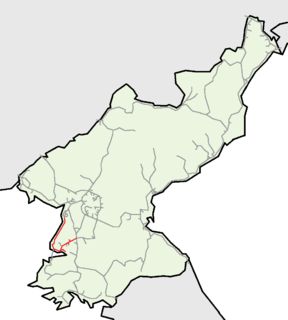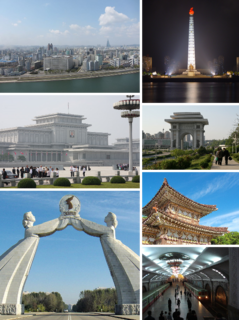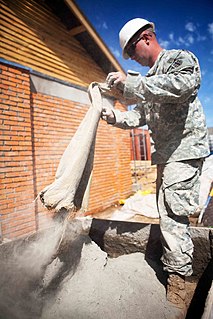P'yŏngch'ŏn-guyŏk is one of the 19 guyŏk of P'yŏngyang, North Korea. It is bordered by the Taedong River in the south and the Potong River in the north and west, and to the east by Chung-guyŏk, from which it is separated by the yard area of P'yŏngyang railway station. It was established as a guyŏk in October 1960 by the P'yŏngyang City People's Committee through a mandate of the Central Committee of the Workers' Party of Korea.
Sŭngho or Sŭngho-gun is a county of North Hwanghae Province, North Korea. It was formerly one of the 19 kuyŏk that constitute P'yŏngyang, but in 2010, it was administratively reassigned from P'yŏngyang to North Hwanghae; foreign media attributed the change as an attempt to relieve shortages in P'yŏngyang's food distribution system.

Pyongyang Station is the central railway station of P'yŏngyang, North Korea. It is located in Yŏkchŏn-dong, Chung-guyŏk.
Pot'onggang Station is a railway station in Pulg'ŭn'gori 1-dong, Pot'onggang-guyŏk, P'yŏngyang, North Korea, on the P'yŏngnam Line of the Korean State Railway.
Sŏp'o Station is a railway station in Sŏp'o-dong, Hyongjesan-guyŏk, P'yŏngyang, North Korea. It is on located on the P'yŏngra and P'yŏngŭi lines of the Korean State Railway.
Sunan Station is a railway station in Sunan-guyŏk, P'yŏngyang, North Korea. It is on located on the P'yŏngŭi Line of the Korean State Railway.
Sŏgam Station is a railway station in Taegam-ri, Sunan-guyŏk, P'yŏngyang, North Korea. It is on located on the P'yŏngŭi line of the Korean State Railway.
Taep'yŏng Station is railway station in Taep'yŏng-ri, Man'gyŏngdae-guyŏk, P'yŏngyang, North Korea, on the P'yŏngnam Line of the Korean State Railway. The station is on the single-track mainline, serving as a halt for passenger trains.

The P'yŏngbu Line is an electrified standard-gauge trunk line of the Korean State Railway running from P'yŏngyang to Kaesŏng in North Korea and further south across the DMZ to Seoul in South Korea; the name comes from the two (theoretical) termini of the line: P'yŏngyang and Pusan.

The P'yŏngnam Line is an electrified standard-gauge trunk line of the Korean State Railway in North Korea, linking P'yŏngyang with the port city of Namp'o and the hot springs at P'yŏngnam Onch'ŏn. The length of the line is 89.9 km (55.9 mi).
Rajin Station is a railway station in Rajin-guyŏk, Rasŏn Special City, North Korea. It is the junction point and terminus of both the Hambuk and P'yŏngra lines of the Korean State Railway. It is also the starting point of a freight-only branchline to Rajin Port Station.
Kangsŏ Station is a railway station in Kiyang-dong, Kangsŏ-guyŏk, Namp'o Special City, North Korea, on the P'yŏngnam Line of the Korean State Railway. It is the starting point of the Taean Line and of the Posan Line.
Sŏp'yŏngyang Station is a railway station in Sŏsŏng-guyŏk, P'yŏngyang, North Korea. It is on located on the P'yŏngra and P'yŏngŭi lines of the Korean State Railway.

Ch'ilgol Station is a railway station in Kallimgil-dong, Man'gyŏngdae-guyŏk, P'yŏngyang, North Korea, on the P'yŏngnam Line of the Korean State Railway.
P'yongyang Choch'ajang is a marshalling yard in Chŏngp'yŏng-dong, P'yŏngch'ŏn-guyŏk, P'yŏngyang, North Korea, on the P'yŏngyanghwajŏn Line of the Korean State Railway, it is the starting point of a branch to the P'yŏngyang Thermal Power Plant.
Namp'o Station is a railway station in Hanggu-guyŏk, Namp'o Special City, North Korea on the P'yŏngnam Line of the Korean State Railway, as well as the starting point of the Tojiri Line. There is an engine house northwest of the station in Munhwa-dong, Hanggu-guyŏk.
The Taean Friendship Glass Factory, located in Choje-ri, Taean-guyŏk, Namp'o, North Korea, is a factory producing plate glass and other glass products.
The P'yŏngyanghwajŏn Line, or P'yŏngyang Thermal Power Plant Line, is an electrified freight-only railway line of the Korean State Railway in Pot'onggang-guyŏk and P'yŏngch'ŏn-guyŏk, P'yŏngyang, North Korea, running from Pot'onggang on the P'yŏngnam Line to P'yŏngch'ŏn, with a branch to the P'yŏngyang Thermal Power Plant (P'yŏngyanghwajŏn), from which the line gets its name).
The Rangrang Line is a non-electrified freight-only railway line of the Korean State Railway in Ryŏkp'o-guyŏk and Rangrang-guyŏk, P'yŏngyang, North Korea, running from Ryŏkp'o on the P'yŏngbu Line to Rangrang,









